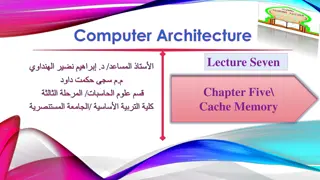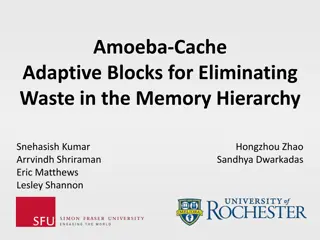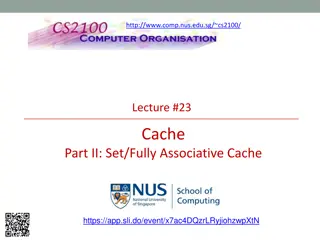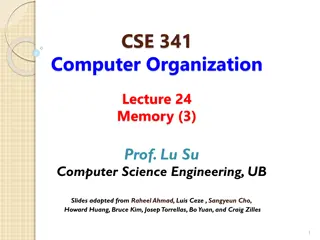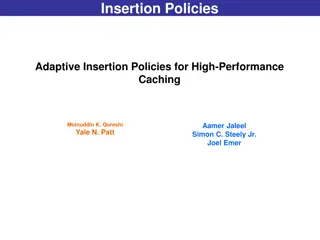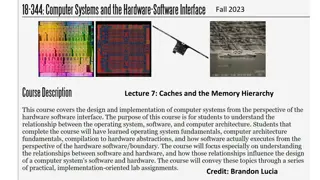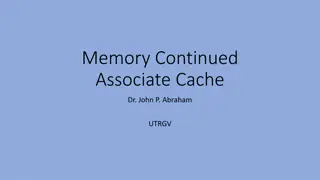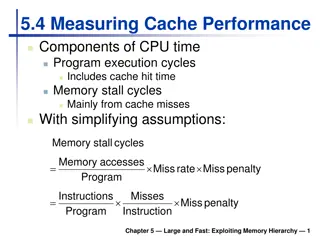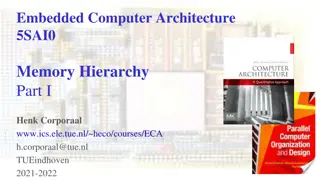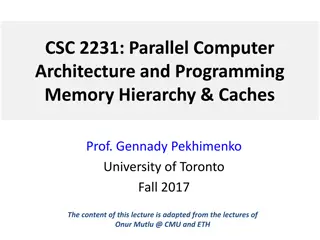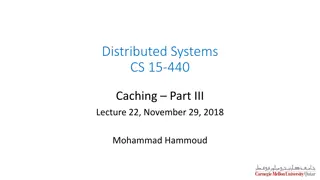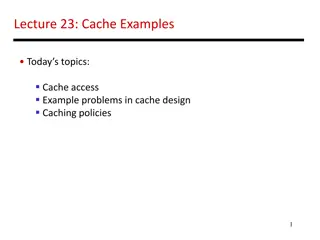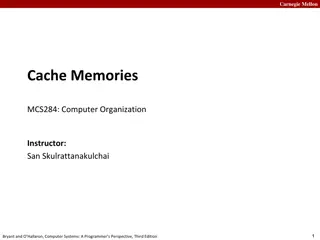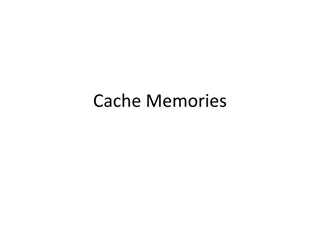Memory Hierarchy Design and Cache Optimization Techniques
This lecture covers the basics of memory hierarchy design and cache optimization techniques, including motivation, basic concepts, cache organization, performance, and advanced optimizations. It discusses the memory performance gap, the basic idea of memory hierarchy, and models of memory hierarchy, highlighting the importance of combining small fast memory with big slow memory to achieve optimal performance. Additionally, it addresses cache power consumption in high-end processors with large on-chip caches.
Download Presentation

Please find below an Image/Link to download the presentation.
The content on the website is provided AS IS for your information and personal use only. It may not be sold, licensed, or shared on other websites without obtaining consent from the author.If you encounter any issues during the download, it is possible that the publisher has removed the file from their server.
You are allowed to download the files provided on this website for personal or commercial use, subject to the condition that they are used lawfully. All files are the property of their respective owners.
The content on the website is provided AS IS for your information and personal use only. It may not be sold, licensed, or shared on other websites without obtaining consent from the author.
E N D
Presentation Transcript
CS5100 Advanced Computer Architecture Memory Hierarchy Design Prof. Chung-Ta King Department of Computer Science National Tsing Hua University, Taiwan (Slides are from textbook, Prof. Hsien-Hsin Lee, Prof. Yasun Hsu) National Tsing Hua University
About This Lecture Goal: To review the basics of memory hierarchy design and cache optimization techniques To understand advanced cache optimization techniques Outline: Memory hierarchy design (Sec. 2.1) Motivation, basic concepts Basic cache organization and performance Basic cache optimizations Ten advanced optimizations of cache performance (Sec. 2.2) 1 National Tsing Hua University
Memory Performance Gap Fig. 2.2 2 National Tsing Hua University
Motivation for Memory Hierarchy Programmers want unlimited amounts of memory with low latency But fast memory more expensive than slower memory Solution: small fast memory + big slow memory = Looks like a big fast memory Big Fast MC MM Small & Fast Big & Slow 3 National Tsing Hua University
Basic Idea of Memory Hierarchy Entire addressable memory space available in largest, slowest memory Incrementally smaller and faster memories, each containing a subset of the memory below it, proceed in steps up toward the processor DRAM eDRAM or Emerging memory DISK SRAM Main Memory Reg File L1 Data cache L4 Cache L2 Cache L3 Cache L1 Inst cache 4 National Tsing Hua University
Model of Memory Hierarchy Cycle Words/cycle Management Registers 1 3-10 ? Compiler CPU Chip 1-3 1-2 ? Hardware Level 1 Cache Level 2 Cache 5-10 1 ? Hardware DRAM Chips 30-100 0.5 ? OS Mechanic 106-107 0.01 Disk ? OS 5 National Tsing Hua University
Model of Memory Hierarchy Fig. 2.1 6 National Tsing Hua University
Cache Power Consumption High-end Ps have >10 MB on-chip cache Consumes large amount of area and power budget Intel Core i7 L1 D$ L2 L1 I$ Shared L3 7 National Tsing Hua University
Underlying Principle: Locality of Reference Locality of reference: Program access a relatively small portion of the address space at any instant of time a program property Temporal locality: If an item is referenced, it will tend to be referenced again soon (e.g., loops, reuse) Spatial locality: If an item is referenced, items whose addresses are close by tend to be referenced soon (e.g., straightline code, array access) Stack Code Array P P t Location 8 National Tsing Hua University
But, Program Behavior Matters Locality depends on type of program Some programs behave well Small loop operating on data on stack (towers of hanoi) Some programs don t Frequent calls to nearly random subroutines Traversal of large, sparse data set Pointer-based data structures Essentially random data references with no reuse Traversal of large sequential data Streaming and multimedia data 9 National Tsing Hua University
Memory Hierarchy Performance Average memory access time between levels = Hit time + Miss rate x Miss penalty Miss penalty: time to fetch a block from lower memory level Access time: time to lower level; function of latency Transfer time: function of bandwidth between levels Transfer one cache line/block at a time Transfer at the size of the memory-bus width 10 National Tsing Hua University
Cache on CPU Performance CPU time = (CPU cycle + memory stall cycles) x clock cycle time Memory stall cycles = memory access x miss rate x miss penalty Assumptions: memory stalls are due to cache misses, hit cycles included in CPU execution cycles, reads and writes have same miss rate and penalty CPU time = instruction count x (CPIideal + memory access/instruction x miss rate x miss penalty) x clock cycle time Cache design becomes more important for CPUs with lower CPI and higher clock rates 11 National Tsing Hua University
4 Questions for Memory Hierarchy Block placement: where in upper level? fully associative, direct mapped, set-associative Block identification: find block in upper level? search and match address tag: block address (= tag + index) + block offset valid bit: tag-index boundary and associativity Block replacement: which block to replace on miss? easy for direct map; random/LRU for associative Write strategy: what happens on a write? Write through and write back Write allocate and not allocate 12 National Tsing Hua University
Comparison of Cache Organization 0x1234 Cache miss as a metric: (causes of cache misses) Compulsory: First access to a block Capacity: Block discarded due to limited cache size and later retrieved Conflict: Block discarded due to conflict in set and later retrieved Coherence: In multicore systems (Chapter 5) Processor Cache 0x1234 0x567 80x91B 10x111 Processor Cache 0x1234 0x567 80x91B 1 Processor Cache 13 National Tsing Hua University
Comparison of Cache Organization Which cache organization can reduce compulsory misses? Which cache organization can reduce capacity misses? Which cache organization can reduce conflict misses? Reduce cache misses = improve cache performance? 14 National Tsing Hua University
Comparison of Cache Organizations Comparisons in terms of space and time: Can access to tag and data arrays be done in parallel? How many comparators and multiplexers are needed? How about wiring in IC layout? How many bits of storage are needed in tag and data arrays? The index bits need not be stored! What is the write overhead? 15 National Tsing Hua University
Write Hit Policy Write through Update next level on every write cache is always clean Lots of traffic to next level (mostly writes) Write back Write to cache and mark block dirty update main memory on eviction (more complex eviction and coherence) Write buffer for write through Processor: writes data into cache and write buffer Memory controller: write contents of buffer to memory Cache Processor DRAM Write Buffer 16 National Tsing Hua University
Write Miss Policy Write allocate: Allocate a new block on each write Fetch on write: fetch entire block, then write word into block No-fetch: allocate block but don t fetch Requires valid bits per word, complex eviction Write no-allocate: Write around cache; typically used by write through Write invalidate (instead of update) Sometimes like to have a read no-allocate irregular accesses on machine with large block size 17 National Tsing Hua University
Replacement Policy: Least Recently Used For 2-way set-associative cache 1-bit per set indicates LRU/MRU; set/clear on each access For >2-way, LRU is difficult/expensive in HW Need to maintain history of access order Not recently used (NRU) A used bit is associated with every block, initially 0 Whenever a block is accessed, its used bit is set to 1 If on an access, all other used bits in a set are 1, they are reset to 0 except the bit of the block that is accessed A replacement pointer is used to look for a block whose used bit is 0 to be replaced Used by Intel Itanium, Sparc T2 Other policies: Pseudo LRU, LRU Insertion Policy (LIP) 18 National Tsing Hua University
Six Basic Cache Optimizations Larger block size Exploit spatial locality to reduce compulsory misses Increase capacity and conflict misses, increase miss penalty Larger total cache capacity Reduce capacity misses Increase hit time, increase power consumption Higher associativity Reduce conflict misses Increase hit time, increase power consumption Giving priority to read misses over writes Check WB on read; if no conflicts, read bypass writes in WB 19 National Tsing Hua University
Six Basic Cache Optimizations More cache levels Main Memory (DRAM) 1 cyc 300 cyc L1$ Miss % * Miss penalty Hit Time 1 cyc 10 cyc 20 cyc 300 cyc Main Memory (DRAM) L1 L2 L3 On-die 20 National Tsing Hua University
Six Basic Cache Optimizations Avoiding address translation in cache indexing Strategy 1: virtually addressed cache VA VA PA P $ P TLB $ PA Physical Cache TLB Problem 1: Every time on a process context switch, the cache must be flushed; otherwise get false hits across processes Cost: time to flush + compulsory misses Solution: add processes identifier tag Problem 2: Two different cache entries may hold data for the same physical address aliases 21 National Tsing Hua University
Six Basic Cache Optimizations Avoiding address translation in cache indexing (cont d) Strategy 1: virtually addressed cache (cont d) Aliases (synonyms): void alias(int *x, int *y) { *x = 1; } Hardware solution: cache controller guarantees that every cache block has unique physical address Software solution: compiler guarantees lower n bits of addresses of aliased variables be the same, where the n bits cover only index+offset fields the 2 variables mapped to same location if direct-mapped cache is used (page coloring) *y = 0; 22 National Tsing Hua University
Six Basic Cache Optimizations Avoiding address translation in cache indexing (cont d) Strategy 2: physically mapped, virtually tagged Index+offset fields are same in virtual as well as physical addresses (no need to be translated), e.g. within a VM page Can start cache tag access in parallel with translation so that physical tag can be compared Problem: limit cache size to a VM page Use higher associativity Use page coloring (see previous page) VA Tag Index Data $ Tag = TLB 23 National Tsing Hua University
Outline Memory hierarchy design (Sec. 2.1) Motivation, basic concepts Basic cache organization and performance Basic cache optimizations Ten advanced optimizations of cache performance (Sec. 2.2) 24 National Tsing Hua University
Five Categories of Optimization Strategies Reducing the hit time Small and simple L1 cache; way prediction Increasing cache bandwidth Pipelined cache; multibanked cache; nonblocking cache Reducing the miss penalty Critical word first; merging write buffer Reducing the miss rate Compiler optimization Reducing the miss penalty or miss rate by parallelism Hardware prefetching and compiler prefetching 25 National Tsing Hua University
1. Small and Simple L1 Caches Can reduce hit time and power Critical timing path of cache: addressing and accessing tag/data memory comparing tags selecting correct set Simple cache: Direct-mapped caches can overlap tag comparison and transmission of data reducing hit time Lower associativity reduces power because fewer cache lines are accessed (see Fig. 2.4) Small cache: Large caches impact clock rate, but recent processor designs opt for higher associativity than larger size (see next page) 26 National Tsing Hua University
Small and Simple L1 Caches 3 factors for favoring higher associativity in L1 caches Many processors take at least 2 cycles to access cache longer hit time due to higher associativity may not be critical L1 cache tends to be virtually indexed to keep TLB out of critical path limit cache size to page size times associativity favoring higher associativity Multithreading increases conflict misses favoring higher associativity 27 National Tsing Hua University
2. Way Prediction Predict the way within the set for next cache access e.g., PC of load instructions to index a prediction table Pre-set mux to select the way only a single tag comparison and can read data array at same time (as if DM) Correct prediction: hit time and power close to DM cache Mis-prediction checks other blocks in the next cycle Prediction accuracy: > 90% for 2-way, > 80% for 4-way First on MIPS R10000 in mid-90s; now on ARM Cortex-A8 Cache Data Cache Block 0 : : : Cache Index Valid Cache Tag Cache Data Cache Block 0 Cache Tag Valid : : : Adr Tag Compare Compare 1 0 Mux Sel1 Sel0 OR Hit Cache Block 28 National Tsing Hua University
3. Pipelining Cache Accesses Pipeline cache accesses to improve bandwidth Faster cycle time, higher BW, but slower hits (in cycles) Longer pipeline increases branch mis-prediction penalty and more cycles between issuing a load and using data Pipelined cache write (Prof. Joel Emer) 29 National Tsing Hua University
4. Non-blocking Cache Non-blocking cache or lockup-free cache to increase cache bandwidth Allow cache to continue supply hits during a miss Requires out-of-order execution CPU Hit under miss: reduces the effective miss penalty by working during miss vs. stalling CPU requests Hit under multiple miss or miss under miss: further lower the effective miss penalty by overlapping multiple misses Significantly increase cache controller complexity with multiple outstanding memory accesses Pentium Pro allows 4 outstanding memory misses 30 National Tsing Hua University
5. Multibanked Caches Organize cache as independent banks to support simultaneous access to increase cache bandwidth and reduce power ARM Cortex-A8 supports 1~4 banks for L2 Intel i7 supports 4 banks for L1 and 8 banks for L2 Sequential Interleaving: spread addresses of blocks sequentially across banks, e.g. 4-way interleaved Fig. 2.6 31 National Tsing Hua University
6. Early Restart, Critical Word First Don t wait for full block before restarting CPU to reduce miss penalty Early restart: request words in normal order and, as soon as the requested word arrives, send it to CPU Critical word first: request missed word from memory first and send it to the CPU as soon as it arrives, then fill the rest of the block Generally useful only in large blocks Tend to want next sequential word, so not clear if benefit by early restart block 32 National Tsing Hua University
7. Merging Write Buffers When storing to a block that is already pending in write buffer, merge requests to reduce miss penalty Wr. addr V V V V Need to initiate 4 separate writes back to lower level memory 100 1 Mem[100] 0 0 0 108 1 Mem[108] 0 0 0 116 1 Mem[116] 0 0 0 124 1 Mem[124] 0 0 0 Wr. addr V V V V One single write back to lower level memory 100 1 Mem[100] 1 Mem[108] 1 Mem[116] 1 Mem[124] 0 0 0 0 0 0 0 0 0 0 0 0 Fig. 2.7 33 National Tsing Hua University
8. Compiler Optimizations For reducing miss rate Instructions Reorder procedures in memory to reduce conflict misses Use profiling to look at conflicts Data Loop Interchange: change nesting of loops to access data in order stored in memory Loop Fusion: combine two independent loops that have same looping and access some common variables Blocking: partition large array into smaller blocks, thus fitting the accessed array elements into cache size to improve temporal locality 34 National Tsing Hua University
Loop Interchange j=0 Row-major ordering i=0 /* Before */ for (j=0; j<100; j++) for (i=0; i<5000; i++) x[i][j] = 2*x[i][j] What is the worst that could happen? Hint: DM cache /* After */ for (i=0; i<5000; i++) for (j=0; j<100; j++) x[i][j] = 2*x[i][j] j=0 i=0 Reduce misses by maximizing use of data in a cache block before it is discarded Is this always safe transformation? Does this always lead to higher efficiency? 35 National Tsing Hua University
Loop Fusion Separate loops that access some common data /* Before */ for (i = 0; i < N; i++) a[i] = 1/b[i] * c[i]; for (i = 0; i < N; i = i+1) d[i] = a[i] + c[i]; /* After */ for (i = 0; i < N; i++) { a[i] = 1/b[i] * c[i]; d[i] = a[i] + c[i];} 2 misses per access to a and c vs. one miss per access; improve spatial locality 36 National Tsing Hua University
Loop Blocking /* Before */ for (i=0; i<N; i++) for (j=0; j<N; j++) { r=0; for (k=0; k<N; k++) r += y[i][k]*z[k][j]; x[i][j] = r; } Some arrays accessed by rows and others by column Cannot store row-by-row or column-by-column X[i][j] y[i][k] z[k][j] k j i k i 37 National Tsing Hua University
Loop Blocking Partition loop s iteration space into many smaller chunks improving temporal locality Maximize accesses to the data loaded into the cache before the data are replaced y[i][k] z[k][j] X[i][j] k j j i k i 38 National Tsing Hua University
Loop Blocking /* After */ for (jj=0; jj<N; jj=jj+B) for (kk=0; kk<N; kk=kk+B) for (i=0; i<N; i++) for (j=jj, r=0; j<min(jj+B-1,N); j++) { for (k=kk; k<min(kk+B-1,N); k++) r = r + y[i][k]*z[k][j]; x[i][j] = x[i][j] + r; }; B is called Blocking Factor Capacity misses from 2N3 + N2 to 2N3/B +N2 39 National Tsing Hua University
9. Prefetching - Overview Predict what data will be needed in future Pollution vs. latency reduction If correctly predict, can reduce miss penalty. If mispredict, will bring in unwanted data and pollute the cache To determine the effectiveness When to initiate prefetching? (Timeliness) Which blocks to prefetch? How big a block to prefetch? (note that cache mechanism already performs prefetching) What to replace? Software (data) prefetching vs. hardware prefetching 40 National Tsing Hua University
Hardware Instruction Prefetching Sequential instruction prefetching Fetches 2 blocks on a miss and places the extra block in stream buffer (One Block Lookahead, OBL) On miss, check stream buffer: if present, move stream buffer block into cache and prefetch next block (i+2) Prefetched instruction block Req block Stream Buffer CPU Unified L2 Cache L1 Instruction Req block RF 41 National Tsing Hua University
Hardware Data Prefetch Sequential prefetching also effective for data Can extend to N block lookahead Strided prefetch If observe sequence of accesses to block b, b+N, b+2N, then prefetch b+3N etc. Example: IBM Power 5 supports eight independent streams of strided prefetch per processor, prefetching 12 blocks ahead of current access Intel Core i7 supports one block lookahead only Prefetching benefits if having extra memory bandwidth that can be used without penalty 42 National Tsing Hua University
10. Compiler Prefetching Compiler inserts data prefetching instructions before data is needed Register prefetch: load data into registers (HP PA-RISC) Cache prefetch: load data into cache (MIPS IV, PowerPC, SPARC v. 9) Prefetching instructions may cause faults, e.g. virtual address faults or protection violations Ideal prefetching: semantically invisible (does not change contents of registers and memory, and cannot cause virtual memory faults) Most processors offer non-faulting cache prefetches (prefetch instr. turned into no-ops if would cause faults) 43 National Tsing Hua University
Supporting Software Prefetching Require nonblocking data cache to allow processor proceeds while prefetching data May cause processor to stall if latency of prefetching is long can use loop unrolling to aggregate larger chunk of computations (see next slide) Issuing prefetch instructions incurs overhead Is cost of prefetch issues < savings in reduced misses? Should focus on references that are likely to be cache misses to prefetch 44 National Tsing Hua University
Unrolling for Software Prefetching /* unroll loop 4 times */ for (i=0; i<N; i++) { prefetch(&a[i+1]); prefetch(&b[i+1]); sop = sop + a[i]*b[i]; } for (i=0; i<N-4; i+=4) { prefetch(&a[i+4],4); prefetch(&b[i+4],4); sop = sop + a[i]*b[i]; sop = sop + a[i+1]*b[i+1]; sop = sop + a[i+2]*b[i+2]; sop = sop + a[i+3]*b[i+3]; } sop = sop + a[N-4]*b[N-4]; sop = sop + a[N-3]*b[N-3]; sop = sop + a[N-2]*b[N-2]; sop = sop + a[N-1]*b[N-1]; For larger miss penalty, larger chunk of computation to overlap with prefetching latency 45 National Tsing Hua University
Summary 46 National Tsing Hua University
Recap Memory hierarchy exploits program locality to reduce average memory access time Types of caches Direct mapped, set-associative, fully associative Cache policies Cache replacement: victim selection, insertion policy Write through vs. Write back Write allocate vs. No write allocate Basic and advanced cache optimization techniques Reducing hit time, increasing cache bandwidth, reducing miss penalty, reducing miss rate, reducing miss penalty or miss rate by parallelism 47 National Tsing Hua University






